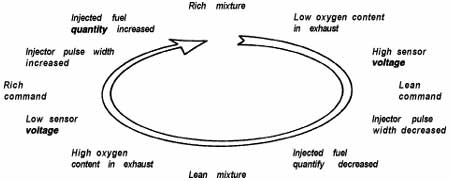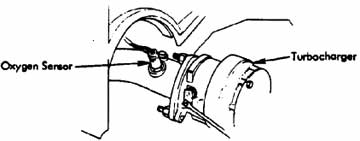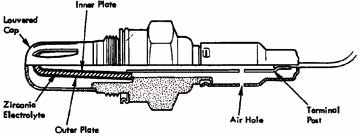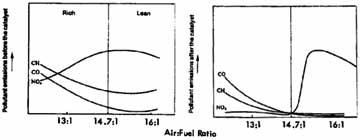
Esprit O2 Sensors
They're in your exhaust pipe controlling your fuel mixture
V8 Oxygen Sensors
The efficiency of conversion of HC, CO and NOx into carbon dioxide (CO2) nitrogen (N2) and water vapour (H2O). is dependent on the amount of oxygen in the exhaust gas, which is a function of the air-fuel ratio supplied to the engine. A ful rich air/fuel ratio results in a low exhaust gas oxygen content, and a lean mixture results in a high oxygen content. In order to maintain a high conversion efficiency of all three pollutants, the air/fuel ratio is maintained as closely as possible to the ideal, or 'Stoichiometric' ratio.

In order to achieve the required close control of air/fuel ratio, a 'closed loop' fuel control system is employed, with oxygen sensors at the inlet to each of the catalytic converters being used to measure the oxygen content of the exhaust gas. The voltage produced by the oxygen sensors can vary between (typically) 900 mV for very rich mixtures, and 100 mV for the leanest. The sensors are designed to be most sensitive around the stoichometric condition, to enable the ECM to determine the necessary correction to be made to the fuel injection command.
In this way, the air/fuel ratio is controlled in a rapid sequence of rich, lean, rich, lean, relative to the ideal stoichiometric ratio.

Low O2 voltage (lean mixture) = rich command
high O2 voltage (rich mixture) = lean commandIn order to determine whether the catalytic converters are functioning effectively, a 'post catalyst' O2 sensor if fitted in the outlet of each starter converter, and by monitoring the exhaust gas oxygen content at this point, the ECM is able to determine converter efficiency. If this should fall below a pre-determind level, the MIL will be lit to alert the driver, and a fault code set.
V8 Cat Removal
Lotus Esprit World was unaware of a way of Removing the Cataylic converters from a V8 without the causing the ECM to go into 'limp' mode, due to the reading from the Oxygen sensors.
An America user has come across a cat sensor blank from a Camaro, that can replace the O2 sensor and fools the ECM. LEW hasn't tested this, but has been told it works:
Post CAT Sensor Blank:
Jeg's part number: 182-104035
$39.99 US Dollars
Phone: 1-800-345-4545
The ECM for the V8 Esprit is off a Chevy Camaro.More info about cat removal on the V8 from P.U.K. Esprit Racing:
Facts:
1. The stock ECU will detect when the cats are removed ;o)
2. This is because the 2. O2-sensors (= After Cat Sensors) will give a not typical reding.
2. The Red Race ignores the 2. O2-sensors !!!
This facts give you different options:
1. Remove the cats and install the Red Race ECU
OR
2. Remove the stock brick (ceramic) cats and install metal cats and leave the stock ECU in place.
OR
3. Remove the stock brick (ceramic) cats and install metal cats and install the Red Race ECU. (This is my personal favourite setup)

Marcus (www.PUKesprit.de)
Email from V8-GT owners
Just noticed you updated the section on removing the V8 cats. Currently my V8-GT has all pre-cat and post-cat sensors in place but the cats are completely hollow. However, the ECM doesn't complain unless you disconnect the sensors altogether and my OBD-II scan software indicates the 'catalyst monitoring' test isn't supported. So V8 cat cat removal may not be as tricky a business as previously suspected, just as long as you have two oxygen sensor sockets in each bypass pipe.BUT, BUT, BUT. There are a mountain of different ECMs used in the V8s, different for GTs, US, single/twin plate clutch, 350, 2002+, etc. So I don't know if this advice holds in all circumstances, I'd be particularly suspicious of the US cars. Anyway the twin plate UK GT is a breeze...
Neal
98 V8-GTEmail from V8-GT owners 2
I have just got back from Blueflame exahasts to have straight through pipes to replace my cats on a V8GT. Firtstly blue flame were excellent.....they started work at about 9 ish and had some major problems getting the old cats off. After that they knocked up two custom pipes which look excellent and I was on my way home at about 1500 Hrs....the cost £200 incl. VAT.There has been a lot of discussion about whether removing the CATS on a V8GT trigger the CEL........my car has the upgraded sports 350 code/ hi torque code and the CEL light has NOT been triggered.
Many Thanks
Paul
1999 V8 GT"
4 Cylinder Oxygen Sensors
A catalytic converter is fitted into the exhaust system in order to reduce emissions of the three major exhaust gas pollutants; hydrocarbons, HC; carbon monoxide, CO; and oxides of nitrogen, NOx. A 'three way' catalytic converter is used, which contains two oxidizing catalysts and a reducing catalyst. A catalyst accelerates a chemical recation without changing its own properties. The two oxidizing catalysts, platinum and palladium use the presence of oxygen in the exhaust gas to convert HC and Co to water vapour and carbon dioxide. In order for this reaction to be efficient, a minimum amount of oxygen is necessary in the exhaust gas. The leaner the mixture supplied to the engine, the more oxygen in the exhaust gas, and the richest air/fuel ratio which supplies sufficient oxygen is 14.7:1.
The reducing catalyst is rhodium, which helps remove oxygen from NOx to leave nitrogen. For this to occur efficiently, the leanest air/fuel ratio is 14.7:1.
Therefore it can be seen that to maintain a high conversion efficiency of the HC, CO and NOx, the air/fuel ratio must be maintained as closely as possible to 14.7:1. This ratio, sometimes called the 'stoichiometric ratio', permits efficient combustion with minimum fuel consumption and maximum driveability.


In order to gauge the air/fuel ratio being supplied to the engine, an oxygen (O2) sensor is fitted into the exhaust outlet pipe from the turbocharger. This sensor is fitted into the exhaust outlet pipe from the turbocharger. This sensor consists of a zirconia electrolyte sandwiched between two platinum plates, with a louvred protective cap. One plate is in contact witht the outside air, and the other with the exhaust gas. The difference between the number of oxygen ions which build up on each plate give rise to a voltage being developed across the plates which varies from around 100 to 900 millivolts dependent on the oxygen content of the exhaust. If the air/fuel ratio is rich (less exhaust oxygen) the sensor voltage will be high, and if the air/fuel ratio is lean, the sensor voltage will be low.
The sensor characteristic is designed to produce a large voltage difference at an air/fuel ratio of 14.7:1 so that the ECM can determine whether the mixture being supplied is too rich or too lean, and the correction command necessary.


4-cylinder Cat Removal
Removing the Cat from a 4-cylinder Esprit is currently an easy job. A full guide can be found here. Remember you may need your cat to pass your MoT and emissions test. So keep hold of it. The oxygen sensor will need replacing back in the system once the cat is removed.
Warm Start Problems
A faulty Oxygen sensor can cause 'warm start' problems and general poor running. To check your O2 sensor is working ok, you can use Freescan (for injection models only). A new sensor is around £70. PUK Esprit Racing can provide a high quality one at a good price if your looking for one.
You can get universal O2 sensors for a heck of a lot less that the Lotus one, but it will have a different connector. Hence you have to keep the original harness and splice the wires from your new O2 sensor. I presume your O2 sensor has 4 wires? Check out:
www.cats-direct-shop.co.uk/lambda-sensors.php
The one you want is INT16334 (zirconia, not titania). Now I must stress I've never tried this sensor myself but given they supply the splicing
diagram to an AC Delco sensor (which is what the Lotus OEM one is) at the bottom of:www.cats-direct-shop.co.uk/lambda-wiring-advice.php
I'd be surprised if it didn't work. Besides it's only 26 quid...
Neal
|
|